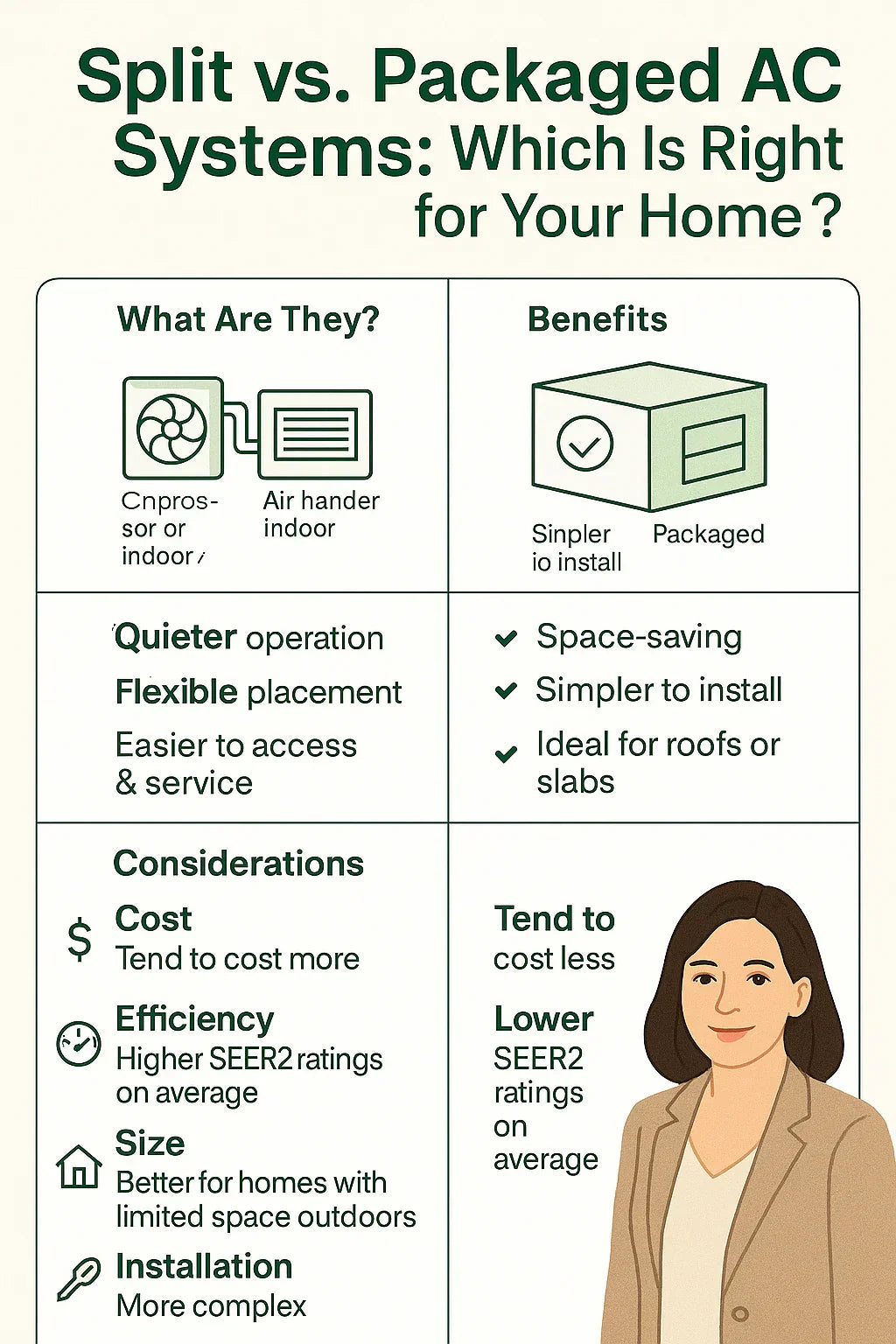🔄 Introduction: Two Ways to Stay Cool
When you're shopping for a central air conditioning system, one of the first decisions you'll face is whether to choose a split system or a packaged system. Both are designed to cool your entire home, but they operate in slightly different ways and are better suited for different situations. In this guide, we’ll break down everything you need to know to confidently choose the system that best fits your home, your budget, and your long-term comfort.
🔧 What Is a Split System?
A split system gets its name because its major components are split between indoor and outdoor units.
🌀 Outdoor Unit:
-
Compressor: Pumps refrigerant through the system.
-
Condenser coil: Releases heat outside.
-
Fan: Expels heat from the outdoor unit.
🏠 Indoor Unit:
-
Evaporator coil: Absorbs heat from inside your home.
-
Air handler or furnace blower: Circulates cooled air through ducts.
🌟 Advantages of Split Systems:
-
Typically more energy-efficient.
-
Easier to access for repairs and maintenance.
-
Quieter indoor operation (because noisy components are outside).
-
More flexible installation options.
❌ Disadvantages:
-
Requires space for both indoor and outdoor units.
-
Installation may be more complex if retrofitting an older home.
For a detailed technical overview, visit Energy Star's explanation of split systems.
🏢 What Is a Packaged System?
In a packaged system, all components are housed together in a single outdoor cabinet, often mounted on the roof or beside the home.
🌟 Advantages of Packaged Systems:
-
Space-saving design; ideal for homes without basements or attics.
-
Easier to install in certain retrofit situations.
-
Simplified maintenance since all parts are in one place.
❌ Disadvantages:
-
May be less energy-efficient than comparable split systems.
-
Noisy operation, as the entire system is outside.
-
Shorter equipment lifespan due to full exposure to outdoor elements.
For more on packaged system pros and cons, check out HVAC.com's comparison guide.
🔢 Side-by-Side Comparison
| Feature | Split System | Packaged System |
|---|---|---|
| Equipment location | Indoor + outdoor | All outdoor |
| Efficiency | Generally higher | Moderate |
| Space requirements | Needs indoor space | Saves indoor space |
| Maintenance access | Indoor access easy | Outdoor access only |
| Noise level | Quieter indoors | Louder outdoors |
| Installation complexity | More complex for retrofits | Easier for some retrofits |
| Lifespan | Longer (protected indoor components) | Slightly shorter (fully exposed components) |
🔥 Which System Is Better for Your Climate?
Hot, Humid Climates:
-
Split systems often perform better due to superior moisture control and efficiency.
Dry, Moderate Climates:
-
Packaged systems may suffice, especially for homes without space for indoor units.
Harsh Winters:
-
Split systems typically offer better cold-weather protection since key components are indoors.
For regional considerations, consult DOE's climate-specific HVAC advice.
💼 Cost Considerations
| Expense | Split System | Packaged System |
| Equipment cost | Slightly higher | Slightly lower |
| Installation labor | Higher (more components) | Lower (simpler setup) |
| Maintenance | Split (indoor/outdoor) | Outdoor-only |
| Total lifespan cost | Lower long-term | Potentially higher due to exposure |
According to HVAC cost guide, while packaged systems may offer lower upfront costs, split systems often offer better total cost of ownership.
🌡 Efficiency Ratings Matter
-
Split systems often come with higher SEER2 ratings, which translate to energy savings.
-
Packaged systems are improving but generally lag behind split systems in efficiency.
A system with a SEER2 rating of 18+ can significantly reduce your electric bills compared to older 10 SEER units.
Learn more about SEER2 standards from official SEER2 resource.
🤝 When to Choose a Split System
-
You value high efficiency and quieter operation.
-
You have space for indoor components (basement, attic, or utility closet).
-
You want longer lifespan and easier maintenance access.
-
Your home has existing ductwork or you're installing ducts during a major renovation.
🤞 When to Choose a Packaged System
-
Limited indoor space makes indoor units impractical.
-
You’re replacing an existing rooftop or side-yard packaged system.
-
Budget or retrofit needs call for faster, simpler installation.
-
You live in a milder climate where outdoor exposure is less of a concern.
🤔 Still Unsure? Talk to a Pro
If you're still debating, consult a licensed HVAC contractor who can assess:
-
Your home's layout.
-
Existing ductwork.
-
Climate and energy cost factors.
-
Long-term maintenance needs.
The right professional can model your home’s unique needs and help you make an informed decision.
For contractor tips, visit Energy.gov's hiring HVAC pros guide.
🌟 Conclusion: Choose What Fits Your Home Best
Both split and packaged systems offer reliable whole-home cooling. The best system for you will depend on your:
-
Home's physical layout.
-
Budget and upfront costs.
-
Energy efficiency goals.
-
Long-term maintenance priorities.
-
Climate considerations.
When in doubt, start by browsing a trusted supplier like The Furnace Outlet, where you can view both split and packaged options with transparent pricing and detailed specs.
In the next topic we will read about: What Size Central Air Conditioner Do You Need? A BTU & Tonnage Sizing Guide







